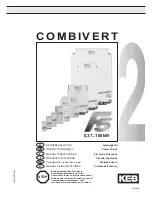
15P0056B1
APPLICATION MANUAL
AMS90/1
16/17
... cont.
INSTALLATION, CALIBRATION AND MAINTENANCE
INSTALLATION, CALIBRATION AND MAINTENANCE
CALIBRATION
The drive is usually delivered with preset calibrations, according to the data received
when ordering the unit, or based on the STANDARD CONFIGURATION.
If calibration data have to be checked or changed, proceed as follows:
a) Reduction of current limit below rating value:
1. Disconnect one of the two cables powering term. 27-28 and insulate it.
2. Connect an instrument for motor armature D.C. measurement.
3. Send a speed reference with intermediate value, close the line remote control switch
and the RUN contact.
4. Check the armature current value through the previously connected instrument, and,
if required, adjust the current value by rotating trimmer (RV7)
I LIM
. The value
shown by the instrument must reach the required continuous value.
5. If an ammeter is connected to terminal 12, check for data consistency, always
remembering that the unit sends a +10V
DC
signal at rated current (10, 20 or 30A,
depending on the circumstances).
IMPORTANT:
The last two operations should be performed in the shortest time. Finally, reset the
supply of the field rectifier circuit (term. 27-28).
b) Maximum speed calibration
1. Start the machine by pressing the start push-button.
2. Rotate the speed potentiometer to the max. value.
3. Turn trimmer (RV9)
n MAX
so that the machine speed is at max. value, and check
that motor rating data, that is max. speed and max. armature voltage, is not
exceeded.
c) Speed ramp adjustment
1. Rotate the potentiometer to the max. value.
2. Start the drive.
3. If the time required by the drive to reach the maximum speed (voltage) is too short
or too long, rotate trimmer (RV4)
UP
. Otherwise, use trimmer (RV5)
DOWN
to
adjust the slope. Note: the drive can control the slope only if the set ramp is longer
than the normal inertia slope (i.e. the one obtained through idle stop). Further, it can
control the rise, provided that it does not enter the current limit condition, i.e.
provided that the rise ramp is not too short.
... cont.





































